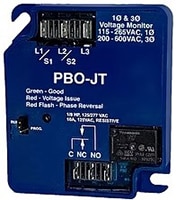PBO-JT, PBO-3P-T, and PBO-1P-T Digital Single- and Three-Phase Voltage Monitors
R-K Electronics digital single- and three-phase voltage monitors protect three-phase motors from line voltage issues
 The R-K Electronics PBO (phase and brown-out) monitors line voltages (single- and three-phase) and will provide a contact output to disconnect equipment (typically three-phase motors) if the line voltages are outside the operational setpoints for over/under voltage, phase loss (single phasing), phase imbalance, and improper phase rotation.
The R-K Electronics PBO (phase and brown-out) monitors line voltages (single- and three-phase) and will provide a contact output to disconnect equipment (typically three-phase motors) if the line voltages are outside the operational setpoints for over/under voltage, phase loss (single phasing), phase imbalance, and improper phase rotation.
There are three versions to choose from:
- PBO-JT
- Monitors 115 VAC to 265 VAC, 1Ø, and 200 VAC to 575 VAC, 3Ø
- PBO-3P-T
- Monitors 208 VAC to 575 VAC, 3-phase
- PBO-1P-T
- Monitors 115 VAC to 265 VAC, 1-phase
The PBO-JT can monitor either single-phase or three-phase voltages. After hooking up the PBO-JT, move the jumper on the top of the case from “Run” to “Prog.” Now apply the line voltage to be monitored. The PBO-JT will take about five seconds to determine if it is a single-phase or three-phase voltage. Then it will determine if the line voltage is within the settings for one of the voltages pre-programmed into the PBO-JT. Once the PBO-JT has selected a voltage, move the jumper to the “Run” position and the PBO-JT will only monitor that voltage.
The PBO-1P-T monitors four single-phase voltages with the tolerances pre-programmed into the PBO. Each time the PBO is powered up, the processor evaluates the line voltage and compares it to the pre-programmed line voltages and tolerances. If the line voltage matches one of the programmed voltages and is within the tolerances, the output relay will be energized and the LED will be green. The PBO will indicate what voltage it is set for by flashing the LED. If a voltage fault is detected, the LED will be red.
The PBO-3P-T monitors five three-phase voltages with the tolerances pre-programmed into the PBO. Each time the PBO is powered up, the processor evaluates the line voltage and compares it to the pre-programmed line voltages and tolerances. If the line voltage matches one of the programmed voltages and is within the tolerances, the output relay will be energized and the LED will be green. The PBO will indicate what voltage it is set for by flashing the LED green in a sequence corresponding to the selected voltage. If a voltage fault is detected, the LED will be red, and if the phases are reversed, the LED will flash red.
On all three units, the LED will indicate the fault condition: solid green means good, solid red means the line voltage is out of range, and flashing red means the phases have been reversed (3P only).
- Monitors voltages
- 115 VAC to 265 VAC, 1Ø
- 208 VAC to 575 VAC, 3Ø
- Digitally selected set-points
- Over/under voltage percentage (15%)
- Phase imbalance percentage (8%)
- Time delays
- Trip times (5 seconds)
- Restart times (15 seconds)
- Relay contact outputs
- SPDT (single pole double throw)
- Packaging
- Epoxy filled
- DIN or surface mounting
- Push-on tabs
- Faults
- Red LED
- Line voltage out of spec
- Flashing red
- Phase reversal (JT and 3P only)
Applications
- Typical applications for the PBOs are associated with three-phase motors. Some of the key industries include
- HVACR (heating, ventilating, air conditioning, and refrigeration)
- Compressor motors
- Fan motors
- Pumping
- Fresh and wastewater pumps
- Irrigation pump motors
- Industrial
- Blowers
- Conveyors
- Heating
- Any single- or three-phase motors







